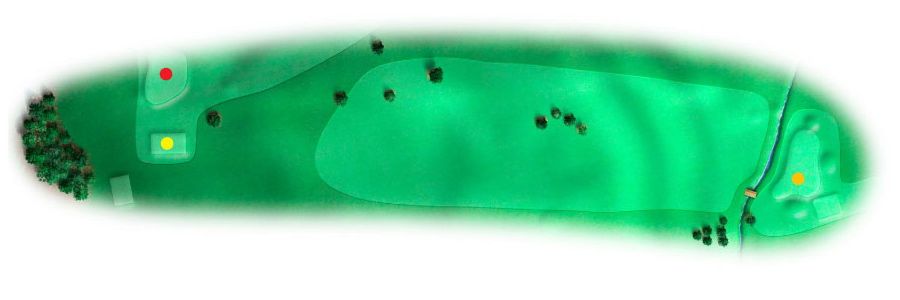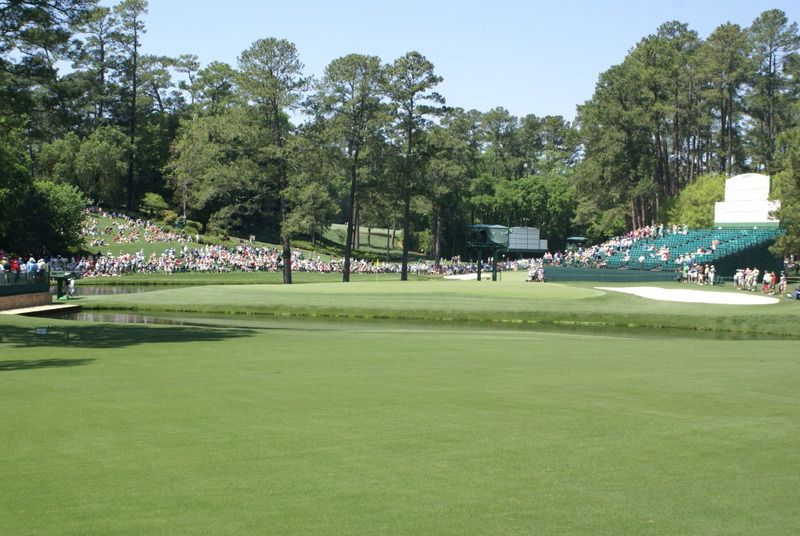Last chance at eagle...
Hole 15 - Firethorn - Par 5


1934 - 485 yards - The scene of Sarazen's double-eagle in 1935. At that time, the water (described as a ditch, ravine, creek, stream and moat) was at least 20 yards short of the green, with a gentle bank, not a steep slope, in between.
1949 - 485 yards - Downstream from the 15th, the creek was dammed and piped underground, backing up water into the hollow and creating the pond in front of the 15th (some called it a lagoon). Its green side slope was now steeper and slicker. A trio of pine trees in the fairway had finally grown sufficiently to become an annoyance.
1957 - 520 yards - A formal dam left of the pond was established in 1955, its walkway designated the Gene Sarazen bridge. The next summer, dirt was hauled in to extend the tee and to create gallery mounds behind and to the right of the green. At the suggestion of Hogan, the right-hand mound was carved into a bunker before the '57 event.
1970 - 520 yards - In 1962, George Cob widened the pond so players could clearly see its leading edge. In 1969, the tee was moved back 40 yards, but the scorecard yardage didn't change. Robert directed the installation of a series of high mounds on the right side of the fairway. Meant as hazards, players ultimately used them to propel drives farther down the hole.
1999 - 500 yards - Without explanation, the official yardage was reduced to 500 yards in 1981. In the summer of 1998, mounds in the rough were removed, and several clusters of tall pines were transplanted in that area (as well as to the left) to drastically tighten the landing zone. Roberts' mounds on the right side of the fairway, mistakenly considered MacKenzie originals, were retained.
2011 - 530 yards - A new tee was built in 2005 30 yards back and 20 yards to the left of the old one. From there, the preferred drive was definitely a face into the gap between the trees. A year later, the Masters tee was extended forward about seven yards to provide the option of moving markers up in certain wind conditions.
Here are Dan's words:
"Always a short, straightaway par 5, the fifteenth has forever been reachable in two, initially because Bobby Jones believed that all par 5s potentially should be, and more recently because the presence of the eleventh fairway leaves no room to extend the tee back any further. Though, at a glance, things may not look too different today relative to the early years, the hole has seen its fair share of changes.
First, what began as a smallish creek meandering before the green was eventually widened, and enlarged into today’s famous pond, though accounts of just when this took place vary, ranging from 1947 through the early 1960’s. Also, a mound sitting just off the right edge of the putting surface was replaced by a bunker – at the apparent suggestion of Ben Hogan – in 1957. Additional mounds around the green have been added and removed, and a controversial series of mounds were added on the right side of the driving zone in 1969.
Of course, nothing has affected the fifteenth quite so much as the effect of trees along its fairway – and not just those installed around the new millennium. Once upon a time, the plain that encompasses parts of the second, third, seventh, fifteenth and seventeenth fairways was largely a wide open stretch, dotted only with the occasional pine tree. Two of those original pines formed the foundation of the large cluster of trees that now cuts into the left side of the fifteenth’s driving zone – so that particular copse is not entirely contrived – but the budding mini-forest which now occupies a stretch of former right-side fairway most certainly is.
And then there is a subtle, yet hugely important, agronomical difference: with the slope separating the front of the green from the pond now maintained with the firmness of a billiard table, the margin for error on approaches coming up fractionally short has been reduced to near nothing – a circumstance which affects heavily spun pitches more than longer irons from atop the hill, and thus might actually induce more players to go for the green in two.
Better Then or Now?
One certainly sympathizes with Masters officials who’ve grown weary of watching longer hitters reach the fifteenth green with short-iron seconds, so the hole’s recent lengthening to 530 yards certainly makes sense. The problem, once again, lies with the addition of rough and trees, both of which run directly against the philosophy of Bobby Jones, who specifically wanted players to have a go at this green in two. Jones wrote favorably of the fifteenth that “The tee shot may be hit almost anywhere without encountering trouble,” because he considered this a necessity in setting up the unique approach that has produced so many of championship golf’s most thrilling moments."
I actually think that this is one hole at Augusta where placing a premium on placement of the tee shot is appropriate (the method of doing so is still up for debate). The reward is a shot at the green, the penalty for poor execution is to have to lay up (with birdie still an option). That being said, the second into the 15th green is one of a few standout moments in the closing stretch of the tournament. There's a fine line between building up the excitement and still asking the golfer to execute shots in order to be in a position to make a move.
As we've seen in recent years, the tournament committee has the ability to change the conditioning around the 15th to make the hole easier or harder, depending on the intentions of the year. With a bit of rough on the bank, the penalty for a miss short is alleviated slightly. Of course, if you haven't maneuvered through the obstacle course in the fairway, the length of the grass on the bank has little effect.
Reading Dan's comments makes me think that the nature of this hole should be dominated by the pin positions, and the fairway should be set up so that the player has the opportunity to place their tee shot in the ideal position for attacking the day's location. I think I'd rather hear the commentators discussing how Player A's drive leaves them a tough angle into the narrow left side of the green, as opposed to hearing them discuss how they are going to play their layup from the pine straw.
